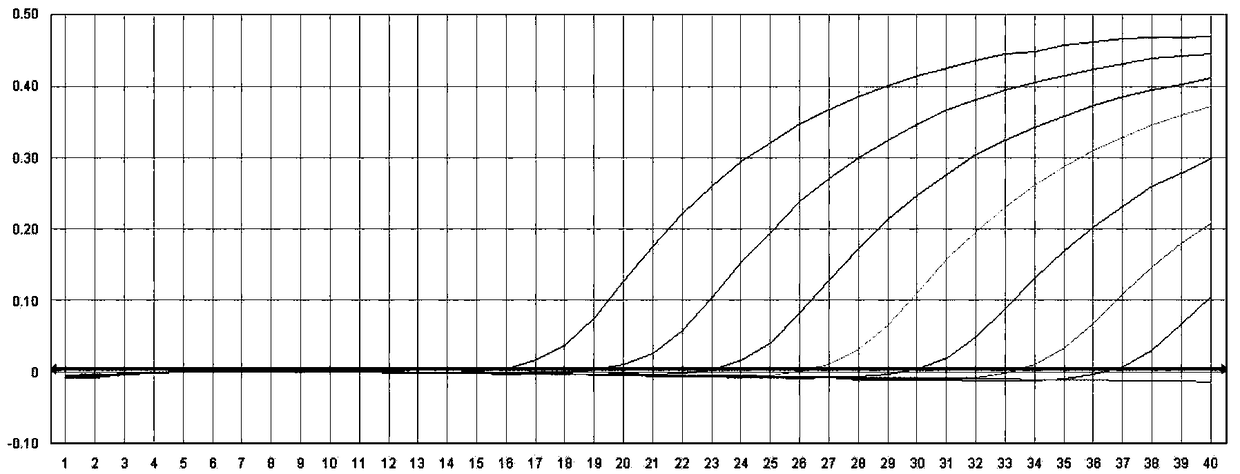Oligonucleotide, method and kit for detecting NonO-TFE3 fusion gene in sample
A NONO-TFE3, oligonucleotide technology, applied in the field of biological science and biology, can solve the problems of high cost and poor specificity, and achieve the effects of simple operation, convenient results, and avoiding hematological recurrence.
- Summary
- Abstract
- Description
- Claims
- Application Information
AI Technical Summary
Problems solved by technology
Method used
Image
Examples
Embodiment 1
[0028] Oligonucleotides for detecting the NONO-TFE3 fusion gene in the sample, the oligonucleotides include at least one of (1) and (2): (1) upstream and downstream primers for type 1 NONO-TFE3 and The base sequences of the probes are SEQ ID NO: 1, 2 and 3, as shown in Table 1. (2) For the upstream and downstream primers and probes of type 2 NONO-TFE3, their base sequences are SEQ ID NO, respectively : 4, 5 and 6, as shown in Table 1.
[0029] Further, the oligonucleotides also include upstream and downstream primers and probes for the β-actin internal reference gene, the base sequences of which are SEQ ID NO: 7, 8 and 9, respectively, as shown in Table 1.
[0030] Oligonucleotides used to detect the NONO-TFE3 fusion gene in a sample. The oligonucleotides include (1) and (2): (1) upstream and downstream primers and probes for type 1 NONO-TFE3, and their bases The base sequences are SEQ ID NO: 1, 2 and 3, as shown in Table 1. (2) For the upstream and downstream primers and probes o...
Embodiment 2
[0048] Operation process of the method of the present invention:
[0049] (1) Extract tissue RNA from blood samples: add 1ml of the red blood cell lysate in Example 1 to a clean 1.5ml centrifuge tube, take 0.5ml of anticoagulant blood and mix well, let stand at room temperature for 10min; centrifuge at 5000rpm for 5min, Discard the supernatant and collect the cells at the bottom; add 0.5ml of the red blood cell lysate in Example 1 again, centrifuge at 5000rpm for 5min, discard the supernatant, and collect the cells at the bottom; add 1ml of TRIzol to the cells and pipette repeatedly until the precipitate is completely dissolved, at room temperature Stand still for 5 minutes; add 0.2ml of chloroform and shake evenly; centrifuge at 14000rpm for 10 minutes at 4°C, transfer the supernatant layer to a new centrifuge tube (do not draw the white middle layer); add an equal volume of isopropanol, and mix thoroughly ,Stand for 10min at room temperature; Centrifuge at 14000rpm 4℃ for 10min...
Embodiment 3
[0063] Example 3 Positive plasmid detection and sensitivity detection
[0064] When preparing a positive plasmid, you can directly synthesize Type 1 NonO-TFE3cDNA and Type 2 NonO-TFE3cDNA, and then insert them into the pre-selected plasmids (here, take PMD18-T plasmid as an example for explanation), thus preparing PMD18 -T / NonO-TFE3-1 positive plasmid and PMD18-T / NonO-TFE3-2 positive plasmid.
[0065] Take the initial concentration as 1×10 11 The positive plasmid of copies / uL is used as a template, press 10 -1 , 10 -2 ……10 -10 Proportional dilution, respectively as a template for experiment, where the concentration is 10 8 , 10 7 , 10 6 , 10 5 , 10 4 , 10 3 , 10 2 The results are shown in Figure 1. The positive plasmid concentration corresponding to each amplification curve in Figure 1 is 10 from left to right. 8 , 10 7 , 10 6 , 10 5 , 10 4 , 10 3 , 10 2 copies / uL. It can be seen from Figure 1 that the primers and probes of the present invention can detect these two types of positi...
PUM
 Login to View More
Login to View More Abstract
Description
Claims
Application Information
 Login to View More
Login to View More - R&D
- Intellectual Property
- Life Sciences
- Materials
- Tech Scout
- Unparalleled Data Quality
- Higher Quality Content
- 60% Fewer Hallucinations
Browse by: Latest US Patents, China's latest patents, Technical Efficacy Thesaurus, Application Domain, Technology Topic, Popular Technical Reports.
© 2025 PatSnap. All rights reserved.Legal|Privacy policy|Modern Slavery Act Transparency Statement|Sitemap|About US| Contact US: help@patsnap.com



